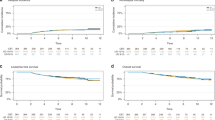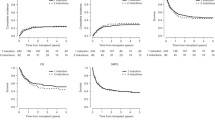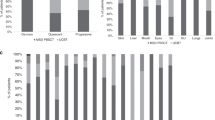Abstract
Graft failure has remained a limitation of umbilical cord blood transplantation (CBT). Here, we assessed the outcomes of patients who experienced graft failure after CBT. Inclusion criteria were patients (age ≥ 18 years) experiencing graft failure after unrelated CBT (single or double) between 2005 and 2016, for acute myelogenous leukemia (AML) or acute lymphoblastic leukemia (ALL), no prior allogeneic or autologous transplantation, no other stem cell product. The study included 87 patients. At 1-year, cumulative incidence of relapse and nonrelapse mortality (NRM) was 35% and 37%, respectively. One-year overall survival (OS) and progression-free survival (PFS) was 40% and 29%, respectively. Forty-six patients underwent a salvage second transplantation with 1-year and 2-year OS and PFS from second transplantation 41% and 34% for OS, and 37% and 34% for PFS, respectively. In multivariate analysis, complete remission (CR) at CBT (HR = 0.45, 95% CI 0.25–0.83, P = 0.01) and reduced-intensity conditioning (HR = 0.51, 95% CI 0.29–0.91, P = 0.023) were associated with better OS. In conclusion, in this retrospective study, we observed that approximately one-quarter of patients experiencing graft failure after CBT remained alive without relapse 2 years later.
This is a preview of subscription content, access via your institution
Access options
Subscribe to this journal
Receive 12 print issues and online access
$259.00 per year
only $21.58 per issue
Buy this article
- Purchase on Springer Link
- Instant access to full article PDF
Prices may be subject to local taxes which are calculated during checkout



Similar content being viewed by others
Data availability
CP, ML, MMo and AN had full access to all the data in the study (available upon data specific request).
References
Ballen KK, Gluckman E, Broxmeyer HE. Umbilical cord blood transplantation: the first 25 years and beyond. Blood. 2013;122:491–8.
Mayani H, Wagner JE, Broxmeyer HE. Cord blood research, banking, and transplantation: achievements, challenges, and perspectives. Bone Marrow Transplant. 2020;55:48–61.
Kindwall-Keller TL, Ballen KK. Umbilical cord blood: the promise and the uncertainty. Stem Cells Transl Med. 2020. https://doi.org/10.1002/sctm.19-0288.
Baron F, Labopin M, Ruggeri A, Sierra J, Robinson S, Labussière-Wallet H, et al. Impact of detectable measurable residual disease on umbilical cord blood transplantation. Am J Hematol. 2020;95:1057–65.
Milano F, Gooley T, Wood B, Woolfrey A, Flowers ME, Doney K, et al. Cord-blood transplantation in patients with minimal residual disease. N Engl J Med. 2016;375:944–53.
Baron F, Labopin M, Ruggeri A, Cornelissen JJ, Meijer E, Sengeloev H, et al. Impact of donor type in patients with AML given allogeneic hematopoietic cell transplantation after low-dose TBI-based regimen. Clin Cancer Res. 2018;24:2794–803.
Ruggeri A, Labopin M, Sormani MP, Sanz G, Sanz J, Volt F, et al. Engraftment kinetics and graft failure after single umbilical cord blood transplantation using a myeloablative conditioning regimen. Haematologica. 2014;99:1509–15.
Baron F, Ruggeri A, Beohou E, Labopin M, Mohty M, Blaise D, et al. Single- or double-unit UCBT following RIC in adults with AL: a report from Eurocord, the ALWP and the CTIWP of the EBMT. J Hematol Oncol. 2017;10:128.
Ruggeri A, Rocha V, Masson E, Labopin M, Cunha R, Absi L, et al. Impact of donor-specific anti-HLA antibodies on graft failure and survival after reduced intensity conditioning-unrelated cord blood transplantation: a Eurocord, Société Francophone d’Histocompatibilité et d’Immunogénétique (SFHI) and Société Française de Greffe de Moelle et de Thérapie Cellulaire (SFGM-TC) analysis. Haematologica. 2013;98:1154–60.
Baron F, Labopin M, Ruggeri A, Ehninger G, Bonifazi F, Stelljes M, et al. Umbilical cord blood versus unrelated donor transplantation in adults with primary refractory or relapsed acute myeloid leukemia: a report from Eurocord, the Acute Leukemia Working Party and the Cord Blood Committee of the Cellular Therapy and Immunobiology Working Party of the EBMT. Blood Cancer J. 2019;9:46.
Kanate AS, Nagler A, Savani B. Summary of scientific and statistical methods, study endpoints and definitions for observational and registry-based studies in hematopoietic cell transplantation. Clin Hematol Int. 2019;2:2–4.
Baron F, Ruggeri A, Beohou E, Labopin M, Mohty M, Sanz J, et al. Occurrence of graft-versus-host disease increases mortality after umbilical cord blood transplantation for acute myeloid leukaemia: a report from Eurocord and the ALWP of the EBMT. J Intern Med. 2018;283:178–89.
Singh H, Nikiforow S, Li S, Ballen KK, Spitzer TR, Soiffer R, et al. Outcomes and management strategies for graft failure after umbilical cord blood transplantation. Am J Hematol. 2014;89:1097–101.
Volt F, Ruggeri A, Scigliuolo GM, de Latour RP, Bierings M, Al-Seraihy A, et al. Umbilical cord blood transplantation after graft failure from a previous hematopoietic stem cell transplantation. Transpl Cell Ther. 2022;28:46.e1–46.e7.
Harada K, Najima Y, Kato M, Fuji S, Shinohara A, Nakamae H, et al. Outcomes of salvage haploidentical transplantation using posttransplant cyclophosphamide for graft failure following allogeneic hematopoietic stem cell transplantation. Int J Hematol. 2022;116:744–53.
Baron F, Ruggeri A, Beohou E, Labopin M, Sanz G, Milpied N, et al. RIC versus MAC UCBT in adults with AML: A report from Eurocord, the ALWP and the CTIWP of the EBMT. Oncotarget. 2016;7:43027–38.
Sheth V, Volt F, Sanz J, Clement L, Cornelissen J, Blaise D, et al. Reduced-intensity versus myeloablative conditioning in cord blood transplantation for acute myeloid leukemia (40-60 years) across highly mismatched HLA barriers-On Behalf of Eurocord and the Cellular Therapy & Immunobiology Working Party (CTIWP) of EBMT. Biol Blood Marrow Transplant. 2020. https://doi.org/10.1016/j.bbmt.2020.07.025.
Ponce DM, Sauter C, Devlin S, Lubin M, Gonzales AM, Kernan NA, et al. A novel reduced-intensity conditioning regimen induces a high incidence of sustained donor-derived neutrophil and platelet engraftment after double-unit cord blood transplantation. Biol Blood Marrow Transplant. 2013;19:799–803.
Baron F, Ruggeri A, Nagler A. Methods of ex vivo expansion of human cord blood cells: challenges, successes and clinical implications. Expert Rev Hematol. 2016;9:297–314.
Horwitz ME, Chao NJ, Rizzieri DA, Long GD, Sullivan KM, Gasparetto C, et al. Umbilical cord blood expansion with nicotinamide provides long-term multilineage engraftment. J Clin Investig. 2014;124:3121–8.
Wagner JEJ, Brunstein CG, Boitano AE, DeFor TE, McKenna D, Sumstad D, et al. Phase I/II Trial of StemRegenin-1 expanded umbilical cord blood hematopoietic stem cells supports testing as a stand-alone graft. Cell Stem Cell. 2016;18:144–55.
Cohen S, Roy J, Lachance S, Delisle J-S, Marinier A, Busque L, et al. Hematopoietic stem cell transplantation using single UM171-expanded cord blood: a single-arm, phase 1-2 safety and feasibility study. Lancet Haematol. 2020;7:e134–e145.
Cohen S, Bambace NM, Ahmad I, Burns LJ, Roy J, Lachance S, et al. Improved outcomes of UM171-expanded cord blood transplantation compared with other graft sources: real world evidence. Blood. 2022;140:1610–2.
Horwitz ME, Wease S, Blackwell B, Valcarcel D, Frassoni F, Boelens JJ, et al. Phase I/II study of stem-cell transplantation using a single cord blood unit expanded ex vivo with nicotinamide. J Clin Oncol. 2019;37:367–74.
Horwitz ME, Stiff PJ, Cutler C, Brunstein C, Hanna R, Maziarz RT, et al. Omidubicel vs standard myeloablative umbilical cord blood transplantation: results of a phase 3 randomized study. Blood. 2021;138:1429–40.
Acknowledgements
We thank Emmanuelle Polge and Audrey Mailhol from the office of the ALWP of the EBMT. FB is Senior Research Associate at the National Fund for Scientific Research (FNRS) Belgium.
Author information
Authors and Affiliations
Contributions
FB wrote the manuscript, designed the study, and interpreted the data. CP and ML designed the study, performed the statistical analyses, interpreted the data, and edited the manuscript. AR, EG, MMo and AN designed the study, interpreted the data, and edited the manuscript. JS, RS, CP, MMi, JHB, CF and WA reviewed the manuscript and provided clinical data. All authors approved the final version of the manuscript.
Corresponding author
Ethics declarations
Competing interests
FB has received travel grants and/or speaker honoraria from Celgene, Abbvie, Novartis, Pfizer and Sanofi. The other authors declare that they have no relevant conflict of interest.
Ethics approval and consent to participate
The scientific boards of the ALWP of the EBMT approved this study. The study was conducted according to the Declaration of Helsinki and Good Clinical Practice guidelines.
Additional information
Publisher’s note Springer Nature remains neutral with regard to jurisdictional claims in published maps and institutional affiliations.
Supplementary information
Rights and permissions
Springer Nature or its licensor (e.g. a society or other partner) holds exclusive rights to this article under a publishing agreement with the author(s) or other rightsholder(s); author self-archiving of the accepted manuscript version of this article is solely governed by the terms of such publishing agreement and applicable law.
About this article
Cite this article
Baron, F., Ruggeri, A., Peczynski, C. et al. Outcomes of graft failure after umbilical cord blood transplantation in acute leukemia: a study from Eurocord and the Acute Leukemia Working Party of the EBMT. Bone Marrow Transplant 58, 936–941 (2023). https://doi.org/10.1038/s41409-023-02000-9
Received:
Revised:
Accepted:
Published:
Issue Date:
DOI: https://doi.org/10.1038/s41409-023-02000-9



